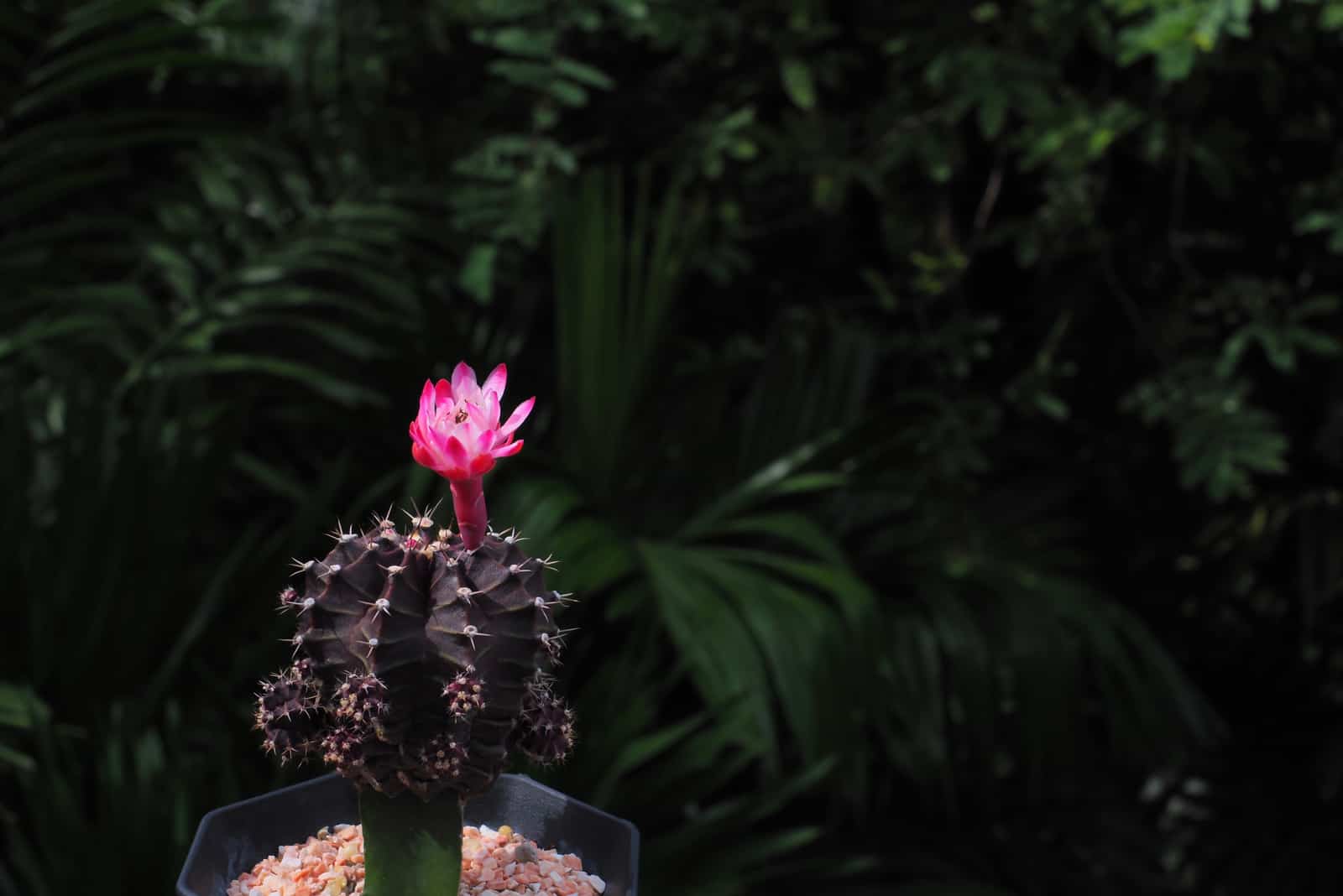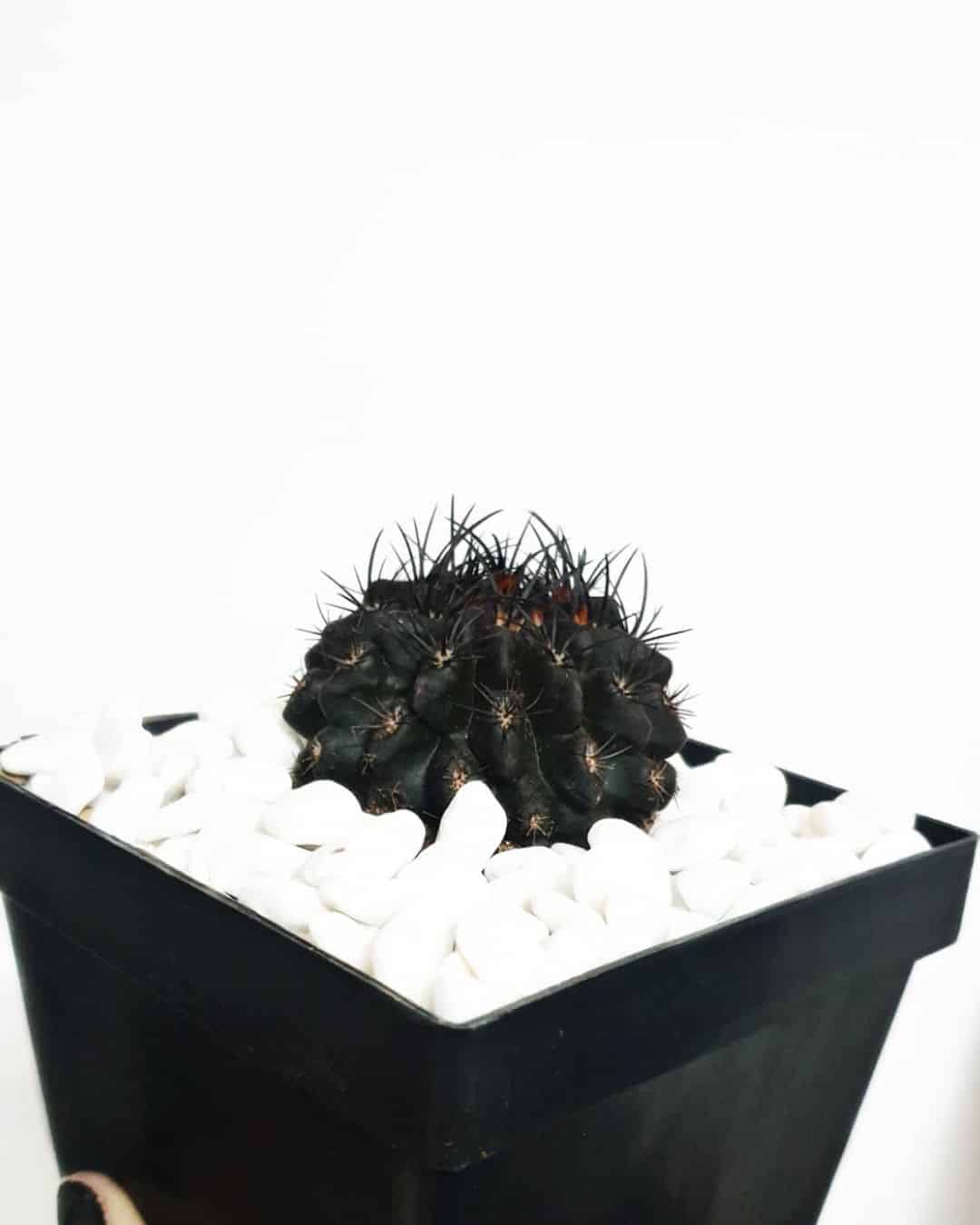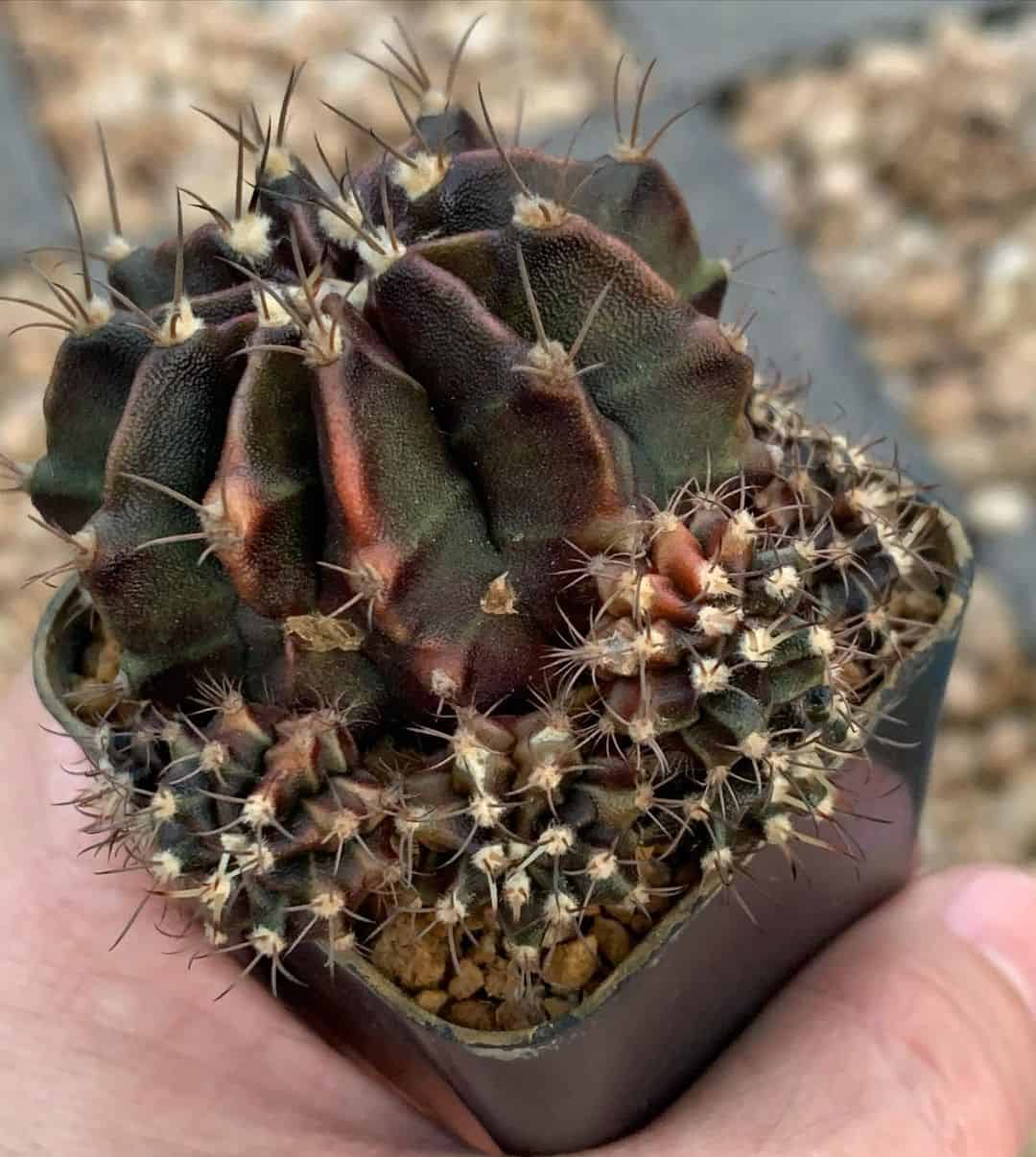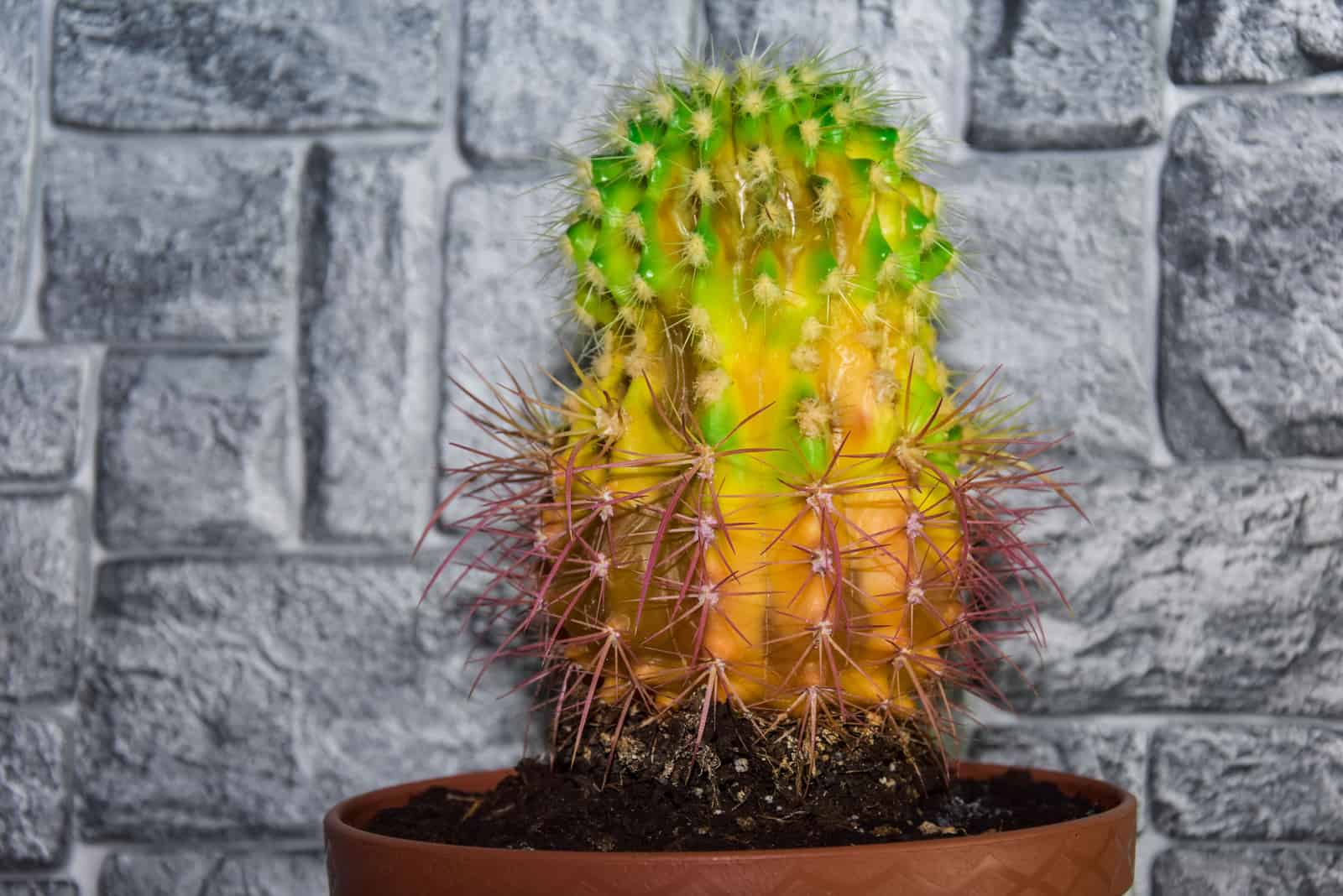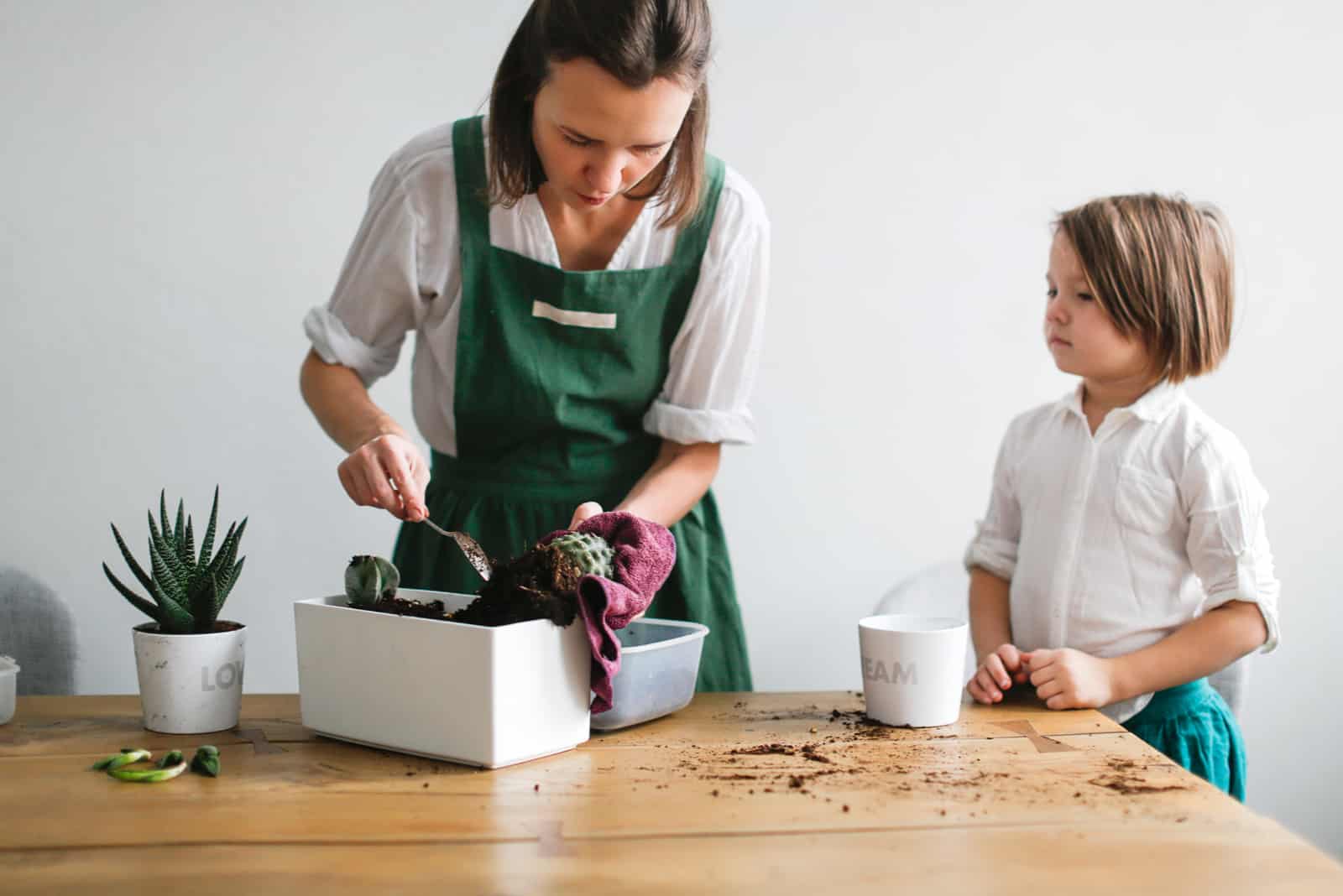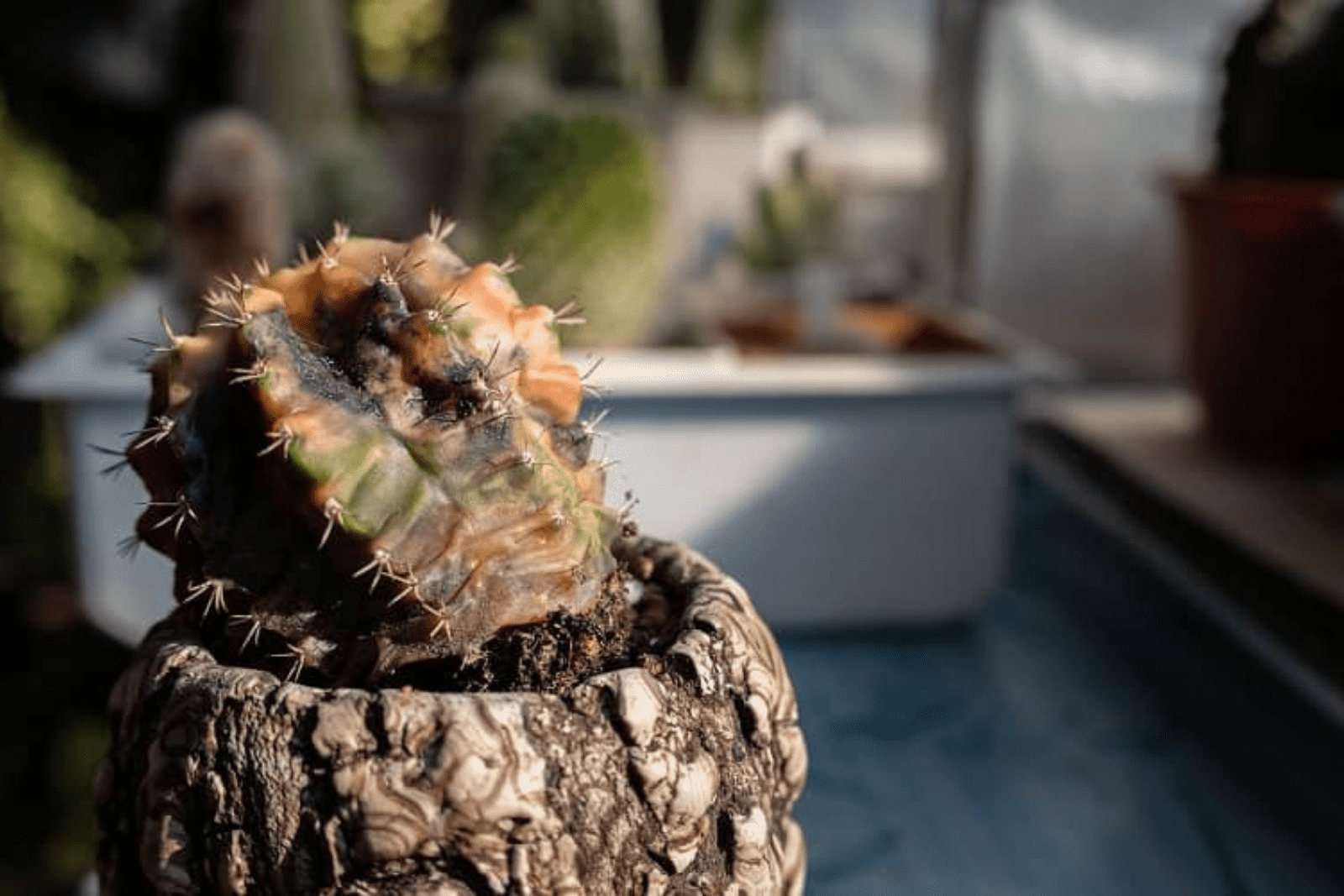Many people buy cacti because they are basically indestructible in addition to being absolutely adorable! However, your cactus may start turning a darker color, which is never a good sign!
So, what might be the reason for your cactus turning black?
Unfortunately, it usually means that your cactus plant has started rotting, but all is not yet lost and you can still save it!
Bear in mind that cacti plants come in various colors, but neither black or brown are one of them — so you should be worried if you notice any brown spots.
Read on to find out the reasons for your cactus turning black, and how to save your precious little plant!
Why Is My Cactus Turning Black?
There are a lot of reasons your cactus plant might be turning black. Even though these plants can survive without water for a long period of time, they still need some moisture in order to survive, so the issue might well be underwatering
On the contrary, you may have been treating your cactus like any other houseplant and watering it frequently.
However, the common issue is not inadequate watering, but rather bacterial diseases.
So, without further ado, let’s figure out the cause of your cactus turning black!
1. Inadequate Watering
Photo from: @getbackbloom
Cacti are famous for their low watering requirements. As we already mentioned, they still need some water; many people think that cactus plants don’t need water at all. This isn’t true, which is why underwatering is a common reason for your cactus turning black.
Some folks take this too seriously and tend to overwater their cactus plants, so let’s find out more about the best way to water your desert dweller.
Underwatering
If you leave your cactus plant without water for a long period of time, the cactus roots will shrivel up and stop absorbing the nutrients essential for their survival. You’ll be able to tell that underwatering is the issue because the soil will be incredibly dry and crusty.
Don’t get me wrong, you should leave the soil to dry out – but it shouldn’t stay dry for too long.
If you continue with watering, then your plant may recover. If not, the soil has probably become too compact and the only way to save it in this case is repotting.
In some cases, sudden watering might shock the cactus’ roots and lead to root rot. You can use a wooden chopstick to check if the bottom of the soil is still moist — if it is, then you can water your plant. Otherwise, repot and lightly water your cactus.
Overwatering
Cacti are plants that have adapted to live in desert regions that are almost completely dry and constantly exposed to the sun. Imagine if you brought your cactus indoors and started watering it every other day, while the poor little guy could literally survive months without a drop of water!
An overwatered cactus is a serious issue.
This is why you should let the soil dry out completely before watering it again. Otherwise, the water will build up in the soil and keep it moist, which creates the perfect environment for bacteria and fungi!
Overwatering usually leads to root rot (this is true for all houseplants), and root rot is a deadly disease that can kill your precious plant.
If your cactus has started turning black and the soil begins to smell — your cactus roots have likely begun to rot.
If it isn’t too late, you can still repot your plant to save it. It’s important that you trim off any decaying and mushy rot, and put the plant in fresh soil. If the roots are completely destroyed, you could try your luck and propagate the plant.
Here is a video about repotting the cactus plant:
2. Bacterial & Fungal Diseases
If you notice any discoloration or black spots on your cactus, your plant is probably suffering from some disease. But don’t worry, you can help your plant to fight it!
Some of the diseases that can be the reason for a cactus turning black include phyllosticta pad spotting, crown rot, and bacterial necrosis.
Phyllosticta Pad Spotting
Several different pests or climatic circumstances can produce lesions on the pads of cacti, though a fungus called Phyllosticta causes the most common pad spot in cacti plants. This fungus can infect aloe, orchids, agave, and yucca plants as well.
Because of the presence of little black reproductive structures called pycnidia formed on the surface of infected plant tissue, lesions appear almost totally black as you can see in the image below.
There are two types of fungi that can cause this disease: ascospores and conidia.
Spores formed within these reproductive structures are easily spread by wind or dripping water to new places on neighboring pads. Because the humidity is higher and moisture often remains after watering, the pads on the lowest section of the plant are often the most heavily afflicted. The fungus is inactive when the pads dry, and the lesions may fall out.
When it comes to conidia, it is transported via water. This usually occurs when you leave a cactus to soak in the rain. In this case, your plant will have spots that are more purple than black and the lesions will get much larger.
Eventually, these spots change shape into a sharper, diamond-like structure.
It can take about six weeks for your plant to display symptoms of this disease, and by then it has usually spread to other parts of your cactus.
To prevent this fungus from spreading, any severely affected pads or entire plants should be removed.
Crown Rot Disease
Crown rot disease can affect many plants — including shrubs, trees, and even some veggies.
Helminthosporium, a fungal infection that produces a lot of airborne spores, causes crown rot in various species of cacti. Splashing water and windborne rain can rapidly distribute these spores. For germination and penetration into the host, they require free water.
The initial sign of infection is dark, sunken, squishy, and water-soaked areas. The afflicted sections of your cactus will eventually turn brown, then dark brown or black. Some of the tissue has died by this point, so there has been some major damage (you’ll notice the dry rot).
The worst thing about this fungus is that it is almost impossible to remove it from the soil — once it’s in, it isn’t going anywhere!
A sad thing is that this fungus usually infects young cacti plants that can’t survive this awful disease (they don’t even have a chance to grow up big and strong!). Adult plants can also get infected, but they have higher survival rates.
Although water management is crucial in the prevention of this disease, no research has been done to date to discover the ideal conditions for disease development. Fungicides like thiophanate-methyl can help prevent infection in areas where illness is a concern. Infected plants should be removed to ensure that they do not spread spores to surrounding plants.
If you see sap leaking out of the affected areas, it’s probably too late to save your plant.
Bacterial Necrosis
If you grow your cactus as an indoor plant, you shouldn’t be too worried about bacterial necrosis because it affects only certain types of cactus, such as saguaro cactus, organ pipe cactus, prickly pear, barrel cactus, and the cholla cactus.
The bacterium Erwinia cacticida causes bacterial necrosis. The first sign is a small, light-colored patch on the surface of the trunk or branches, with a water-soaked edge that can easily go unnoticed. The tissue beneath the infected site quickly turns brown or black.
The tissue may break and leak a dark brown liquid as the disease worsens. If degradation is slow, liquid secretions may not be present in the tissue. The woody structure is exposed as diseased tissue breaks down, and at this point you might see the skeleton of your cactus plant!
The E. cacticida bacteria can live for a long time in soil or plant tissue. Insects and soil affected by this bacterium can transmit it. Insects, weather-related incidents, or rodents cause wounds on roots, trunks, and branches that lead to infection. Plants that are dead or dying serve as bacterial reservoirs and suppliers of bacterial inoculum for future diseases.
While bacterial necrosis can be treated, it is always better to catch the disease early. Bacterial necrosis can only be treated by manually removing the affected region with a clean, sharp, sterilized knife. Let the wound heal naturally. Older infection sites that exude a dark liquid, particularly those near the plant’s root, are untreatable. Remember that bacteria can survive in the soil or ground, so your cactus plant may not be completely safe. If this has happened in your outdoor garden, remove all infested plant material from the area and keep it away from other plants.
3. Pest Infestation
Photo from: @napoldej8668
Some of these annoyances include mealybugs, spider mites, and scales.
Mealybugs infestation is usually detected by white and dry patches all over the cactus. These can be easily treated by insecticidal soap or using neem oil.
Scales have brown, disc-shaped bodies that are easily spotted. Sometimes these bugs have a waxy coat that gives them the appearance of white cottony tufts adhering to the cacti’s pads and stems. These insects absolutely love munching on your plant and stealing all of its nutrients!
Scales are normally handled by washing the insects off plants with a strong stream of water. An application of insecticidal soap may be required if the infestation is severe or the insects return.
Mites are not insects, but they do have a close relationship with spiders. Mites are extremely tiny and can only be seen under a microscope or with a magnifying lens. They cause malformations in plants by injecting a substance into the plant tissue that causes galling. It’s possible that stems, leaves, and flowers will be affected. Mites are kept at bay by spraying or washing the plant on a regular basis to maintain a high level of humidity around it. Washing will also help minimize mite populations by removing mite webbing.
You can even use rubbing alcohol to get rid of these annoyances, but I usually prefer using neem oil or some other type of organic pest control.
4. Low Light Conditions
These plants originate from deserts, where they are constantly exposed to the sun. The best plant care is always mimicking the plant’s natural habitat, so they’ll need lots of sun exposure!
If your cactus starts turning black at the top, it might be unhappy with the light conditions that you have provided. They often do this if the light is too low, so if you notice your cactus growing thinner than it normally would and pointing in one direction, it’s trying to get some more light.
Sometimes young cactus plants can get sunburn if they are still not established — in this case you should keep them in partial shade and slowly move them toward the sun as they grow.
5. Extreme Temperature Changes
When winter is approaching, cacti turn black for the reason as with low light conditions – they love warm weather and the sun.
These plants are not used to low temperatures and cold drafts, which is why they aren’t suitable for outdoor gardens if you live in an area with colder climates.
If you have been growing your cacti in containers, simply bring them indoors where it is warmer. Keep them warm throughout the winter; temperatures from 75 to 80 degrees Fahrenheit will be great for these plants.
Don’t put them anywhere with cold drafts such as near windows or air conditioning — if you do, you’ll probably notice tiny black spots all over your cacti.
If you leave them to overwinter in these conditions they probably won’t wake up from their hibernation.
6. Too Much Plant Food
Over or under-fertilization are also common cactus problems.
You know what else there is in the desert?
A lot of dry, sandy soil that lacks nutrients! Cacti have already adapted to a lack of nutrients, so if you keep giving them plant food they are bound to turn black!
If you notice the base of the plant turning black, you are probably giving your cactus plant too much fertilizer. If you continue to do so, chemicals will build up in the soil and prevent the cactus roots from absorbing the water and nutrients they need to survive.
I would recommend you invest in a high-quality fertilizer suitable for your desert succulent and follow the manufacturer’s instructions on the packaging.
7. Under fertilization
Even though this plant is used to growing in soil low in nutrients, you can’t just leave your cactus to live without any plant food at all! They still need some nutrients to grow and develop.
If you don’t provide your cactus with some type of fertilizer it will stop growing and, you guessed it, turn black!
Bear in mind that they don’t display symptoms of under fertilization quickly, so they have probably been left without plant food for a long period of time, which is why they are now sad and dying.
You must feed your cacti ASAP in this case!
Tips And Tricks For Treating Cacti With Black Spots
If you notice that your cactus has started turning black, you have to act fast! If you are dealing with a fungal infection, it can easily spread and infect your other plants!
Here are a few things that can help you deal with a cactus turning black.
Remove Infected Areas
The disease will continue growing and spreading, so it’s best to nip it in the bud immediately by removing infected areas. The infection cannot spread if there isn’t any on your plant to begin with!
It is important that you sterilize the pruning shears or scissors before and after cutting the infected area so you avoid spreading any pathogens when you use them again.
I recommend you cut layer by layer so you can see how deep the infection has penetrated. Remember that your plant isn’t only hurting on the outside, it’s damaged on the inside as well!
You will have to cut the cactus arm until you reach an area without any rot or black spots.
It’s completely normal to have to cut many layers until you reach healthy plant tissue — nonetheless, don’t stop until you have cut away all of the brown parts or your plant might get infected again!
Keep The Infected Plant Away From Others
We previously mentioned that many diseases can be spread by the wind to other plants near your affected plant, and the same thing goes for pest infestation.
To keep your other houseplants safe and sound, I suggest you immediately isolate your black cactus plant and deal with it in another location.
Once your plant is all better, you can bring it back to hang out with the others!
Change The Potting Soil
Whether it’s bacteria, fungi, or chemical buildup that’s causing your cactus to turn black, the best thing you can do is repot your cactus plant in a brand new potting mix.
Remember that the fungus that causes crown rot can live in the soil for a long period of time, and it is almost impossible to get rid of it. Therefore, repotting is essential if you want to save your plant.
You can either use a store-bought succulent or cacti mix or make your own. This is done by mixing potting soil with perlite, gravel, grit, or crushed granite to improve soil aeration.
You Might Have To Cut Again
You might occasionally miss a few spots when removing the infected areas, and the diseases will likely come back again if you do!
In this case, you will have to cut these areas once more.
Please note that you should always use sterile shears when pruning any type of plant because some of the bacteria might get on the shears and pass to other healthy plants.
If your cactus hasn’t rotted after a few days or weeks, the areas where you cut should harden and create a callus.
The cactus will then begin to regenerate from the cut area, and soon you will be able to see some new growth!
Correct Plant Care Is The Key
You have seen that sometimes cacti might turn black because of inadequate growing conditions, such as cold temperatures, low lighting conditions, overwatering, etc.
Therefore, proper plant care is key to keeping your cacti happy, healthy, and green!
If you are a beginner gardener, please note that this applies to any type of plant; always try to mimic their natural habitat.
If you have been constantly watering your cactus and it starts to turn black, you know what you have to do — stop watering and let the soil dry out before watering again.
Remember that these plants love full sun exposure, soil with low nutrient content, and watering every now and then!
Frequently Asked Questions
1. What causes a cactus to turn black?
There are a few reasons for a cactus turning black. First, you might be using either too much water or too little water — it always helps to check the soil before watering. Remember that cacti are desert succulents that prefer dry soil. Some other reasons include low lighting conditions and over fertilization.
In some cases, too little watering and under fertilization can be the reason for your cactus turning black. Remember that we are dealing with a plant, and even though they are from the desert, they still need some water and nutrients to survive.
However, the most common reasons are fungal diseases, specifically crown rot, bacterial necrosis, and root rot.
2. What are the symptoms of black fungus on cacti?
The symptoms of black fungus on cacti start with stunted growth, discoloration, and black and brown spots appearing, which is often followed by rotting. Sometimes your cactus will leak sap from the infected areas, which indicates that it’s in serious danger!
3. How do you remove black fungus from a cactus plant?
You can use a fungicide to treat black fungus. For instance, I usually go organic and use either copper fungicide or neem oil to treat fungal infections. Please note that copper fungicide is used as a preventative measure rather than a treatment.
However, the most effective method is removing the infected areas to stop the disease from spreading to other parts of your cactus plant. This is done by using sterile pruning shears and cutting layer by layer to remove any trace of the infection.
Final Words
Fortunately, you can save your cactus plant if it begins to turn black.
A cactus turning black is a common issue with these types of plants, and it’s usually due to improper plant care or fungal diseases. However, you can deal with any type of issue and nurture your cactus back to life — its spikes will be as sharp as swords before you know it with our plant care guide!
Taking care of cacti doesn’t require a lot of time and energy, but you still have to provide them with the right growing conditions.
Until next time!
Like this post? Share or pin it for later!

